Thursday, April 30, 2015
13 Best Foods for Your Gut Health
The Gift of My Anger
I wasn't always this way. Oh, no. I was always a "good girl." All throughout my childhood, my teens, my 20s and well into my 30s, I was a sweet, happy-go-lucky good girl. Then something happened -- actually, something kept happening, and that something was something that felt truly and deeply awful. That something was panic disorder. I started having severe panic attacks in my late teens. When they would revisit me, I experienced times of great stress. It wasn't until I began therapy in my 30s that I was able to uncover the root issue, which was suppressed anger. The really interesting thing was that I wasn't even aware I was angry when the panic attacks were triggered. That's how suppressed my anger was. Once I understood that, I began to understand myself a lot better.
I was raised in a family where my anger was frowned upon or discounted. I also learned somewhere along the line that that young ladies didn't get angry and so, anger -- mine, my parents', or anyone else's made me highly uncomfortable. I learned to be a master mediator -- a skilled anti-anger, non-confrontational person. I am happy to say that person no longer exists.
I now get angry and I love it. I know that when I get angry it is because some boundary has been crossed or violated. I never sweep my anger aside or suppress or repress it. I've learned to deal with it in a direct and effective way. I never go off half-cocked and start screaming and yelling at someone. In fact, it is extremely rare that I do scream and yell. I've also learned to keep to the original issue that made me angry and not veer off into a litany of other "wrongs." Because anger can be a tricky and sticky thing where many other issues (sometimes related and sometimes not) and other triggers can all come together in both the heat of the moment and in our efforts to be heard as well as to protect ourselves from further violations. People with hair-trigger responses need to count to at least 10 or take deep breaths and manage their anger. I find I'm at the very opposite end of the spectrum, needing to make a point of addressing my anger at first go (otherwise, I'm presented with repeating patterns that ask me to express my anger clearly.) Anger, like all of our emotions, is a gift -- unwrapping it wisely helps us to understand our selves better and live our lives more fully.
When I am angry, I ask myself these questions:
- Why am I angry? Has some personal boundary been crossed?
- How angry am I? When I become fully enraged it is usually a sign that it's an old issue -- an old trigger that needs to be looked at and addressed outside of the heat of the moment.
- How can I effectively deal with this anger? Do I need to speak up? Usually, the answer is yes, though I've often had butterflies in my stomach. Clear and effective communication is both necessary and courageous. Often, boundaries need to be stated more than once so that they remain clearly marked.
- How can I release this anger? Am I addicted to my anger? Sometimes, I find my anger lingers even after it has been addressed. When this happens, I do one of several things to get the anger out of my system. Either I write a letter that I do not send or vent to a compassionate friend or sometimes, I find listening to rock music at all volumes and dancing around like a teenager really helps.
-- This feed and its contents are the property of The Huffington Post, and use is subject to our terms. It may be used for personal consumption, but may not be distributed on a website.
Starbucks Launches 'Express Format' Store For Crazy-Impatient Customers
According to a Starbucks press release, this pilot project is the "espresso shot" version of a normal Starbucks store. At 538 square feet, the express format store is standing room only and features a "tailored" -- read: more limited -- menu. Also gone are the coffee tables, comfy chairs and sitting spaces seen in most stores; instead, they've been replaced by sleek wooden paneling and laser-etched designs.

Customers will also order drinks differently in this new store. As soon as patrons get in line, a Starbucks employee will take their order with a handheld electronic device. Starbucks says this is a step to "manage wait times," ensuring that busy customers can get back to their days as soon as possible.
To cut down on the amount of time it takes to purchase and pick up drinks, Starbucks will also integrate the Mobile Order & Pay feature on its app, so patrons can keep track of wait times at the express store and grab their coffee on the go.

Starbucks hopes to add four more express format stores in New York City this year, but we're not sure if it's all good news. For one thing, although the new ordering system certainly sounds efficient, it also makes it seem like Starbuck's current system isn't quite as quick as it could be. And are people really that stretched, waiting a few minutes in line for coffee?
All we know is, everyone in Europe is probably shaking their heads at Americans who want to make getting their coffee as close to an assembly line experience as possible.
H/T Eater
-- This feed and its contents are the property of The Huffington Post, and use is subject to our terms. It may be used for personal consumption, but may not be distributed on a website.
New prostate cancer treatment has promising results in mice
New origin theory for cells that gave rise to vertebrates
Sonny Miller's Lesson for Us All: 'Nature Dictates'
Six years ago, I called him. "I've written a movie, it takes place in the water. I hear you're the guy. Can I send it to you?" He called me a few weeks later. "Yeah, I like it, I like it. It really captures what it's like, right?" I told him I didn't have any money, but I was working on it, and that if I ever got the money the question I have is: How do you make an indie in the ocean?
"Yeah, yeah, we can do it." He talked about formats and boogie boards and Go Pros and jet skis. "At the end of the day, though, nature dictates."
He repeated that phrase again and again last summer: "Nature dictates." I'd say, "I know Sonny, I know, but I've got to get this. If I don't get her saying the line over her right shoulder before the wave comes, I don't have the scene." "Yeah. Yeah. Right shoulder. It'll be good. Let's go."
And out we'd walk. Out there. Once a day, he'd say: "You can talk about it so much, and then you gotta just get out there." He carried this box, this box that paid for his house, and his motorcycles and his dying mom's care, and his food and his way of life. I don't know what that was, his way of life, but I heard rumors it included putting up friends and their babies who found themselves between places to live, five dogs, that sort of thing. All paid for by this box he made to make movies in the water. That thing never left his side. I took him to breakfast once, and he brought it to the table.
He'd show up early every day, driving all the way up from San Diego. We'd wrap at seven at night. I'd say, "Sleep in my guest house. We have to be back here at 7 a.m. " "No, I'm good. I'm good." I found out later that he had to get home to check on his mom.
When Sonny arrived at work, he didn't park as much as make a park where his van ended up. He pulled out two bamboo rods and a rattan awning, some aloha fabric, a video monitor, some chairs. Everyone who went in there took a deep breath and smiled. He was pretty much always smiling.
After we made the movie, that is after I got him and everyone to work for half of what they should be paid, after that, we worked some more. The movie was done, but there was so much more to shoot. And, except for one guy on Oahu who never came here and hadn't grabbed onto the movie like Sonny had, Sonny was the only one who knew how to do it.
So, he came, paid even less now for these after-wrap days, he and these beautiful watermen and women whose job it was to keep me from drowning. We shot and we shot. He'd get on the back of a jet ski and point that box at me while I surfed, or fell. While I surfed and screamed during the hardest year of my life. Sonny helped me put this thing on film: A story about a 50-year-old woman who's been through a really, really bad thing and loves the world anyway. He was the perfect person to do it.
We'd go out afterwards, nine hours in the water of afterwards, and they'd drink. So much. People drink so much. But not Sonny. Not on those days, anyway. Not a sober guy. He'd order some Hawaiian cocktail, but like me, he'd drink it slow, or he drank not so I noticed. And he'd talk. About a director he worked with. How the director, on the first day of shooting said, "I'll trade in all these trucks and people for six weeks of Sonny and that box in the water. That's how the movie will get made."
"Yeah," Sonny said, thinking about that director, "He's a good guy, but always picking up women. He had a beautiful wife. I don't get that." I wept inside.
He went out there and out there with me. I'd say, "I need details, of the first time she stands up, hands feet." "Yeah, we'll get it." Sonny would say. "Let's get out there." Out we'd go, water logged, Sonny walking backward, fins flapping, me with my giant yellow board held out of harms way by one of my stuntmen/surf valets necessary to keep me from killing myself.
All these talented people had worked so hard to design it, set it up, but at the end of the day, it was him and me. You don't use lights in the ocean or hair or make up. There's no sound out there. At the last minute even the stunt guys have to duck out of the way. So, in the end, it was Sonny and me.
Sonny died weeks after we finished. Out of nowhere, far as I can tell. His mother died a week before. Thank God, I have to think. But I wonder about his dogs and about why my heart feels so broken. It's him, not me. I've heard people say this, I've even said it, but now I want to go back in time and unsay it, so it can apply only to Sonny. They made exactly one like him.
"Nature dictates."
I'm going to be like that. In the water, smile on my face, loving the world anyway. I am like that, just not quite as much as him.
-- This feed and its contents are the property of The Huffington Post, and use is subject to our terms. It may be used for personal consumption, but may not be distributed on a website.
For seniors on Medicare, choosing a healthcare plan is no easy task
Breakthrough provides new hope for more effective treatments for patients with HER2+ breast cancer
Scientists discover key driver of human aging: May lead to slowing or reversing aging process
Global Cancer Death Rates Appear To Be On The Decline
Published: April 29, 2015 09:00am ET on LiveScience.
The rate of deaths from cancer appears to be declining worldwide, a new study suggests.
Researchers analyzed information from death certificates in 60 countries between 2000 and 2010.
The total number of cancer deaths increased over this time period, due to the growing world population, and the fact that people are living longer. But the rate of cancer deaths — that is, the number of deaths per 100,000 people — declined by about 1 percent per year during the decade, the study found.
In particular, there was a decrease in the rate of deaths from stomach cancer in almost all countries, a decrease in lung cancer deaths among men, and a decrease in breast and prostate cancer deaths in developed countries, according to the study.
Part of the reason for the overall decline may be the decreasing smoking rates in developed countries, along with improved early detection and treatment of cancer, said study researcher Dana Hashim, a postdoctoral fellow in preventive medicine at Mount Sinai Hospital in New York City.
However, the death rate from lung cancer increased among women in most countries, likely because women in these countries are now adapting the smoking habits that were formerly seen among men, Hashim said.
In addition, the rate of deaths from some cancers increased in less-developed countries: There was an increase in the rate of breast cancer deaths among women in less-developed countries. And the rate of death from prostate cancer was inconsistent (not consistently increasing or decreasing) in less-developed countries.
The findings suggest that, although the rate of death from cancer is on the decline in developed countries, there could now be an uptick of some cancer deaths in some developing countries. "It seems like the burden [of cancer] is switching" to low- and middle-income countries, Hashim said.
The initiation of more public health and prevention programs in less-developed countries may help reduce some of this burden, Hashim said. [10 Do's and Don'ts to Reduce Your Risk of Cancer]
To make sure the estimates were as accurate as possible, the researchers included information only from countries that had reliable data from death certificates, in which more than half of the population was represented. However, this meant that a number of countries could not be included in the study — for example, the study included just one country in Africa, and did not include China or India, the world's most populous countries. For this reason, the study was not representative of the entire world population.
The study was presented April 21 at the meeting of the American Association for Cancer Research in Philadelphia.
Follow Rachael Rettner @RachaelRettner. Follow Live Science @livescience, Facebook & Google+. Original article on Live Science.
- 6 Foods That May Affect Breast Cancer Risk
- 8 Tips for Healthy Aging
- Never Too Late: 5 Bad Habits You Should Still Quit
Copyright 2015 LiveScience, a Purch company. All rights reserved. This material may not be published, broadcast, rewritten or redistributed.
-- This feed and its contents are the property of The Huffington Post, and use is subject to our terms. It may be used for personal consumption, but may not be distributed on a website.
Discover America's Next Hot Food Cities

10. San Antonio, TX
Delicious as they are, there's more to this town than Tex-Mex puffy tacos. The Alamo City dining scene has long been passed over for hipper places like Austin and even tiny Marfa, but its growing restaurant culture is now getting its proper due and scores high marks for culinary leadership, thanks to acclaimed chefs like Michael Sohocki (Restaurant Gwendolyn), David Gilbert (Tuk Tuk Taproom) and Andrew Weissman (Osteria Il Sogno), as well as upstart events like the San Antonio Cocktail Conference.
9. Phoenix/Scottsdale, AZ
Today's Phoenix/Scottsdale's restaurant culture bears little resemblance to the one 10 years ago. Creative chefs are currently drawing inspiration from a rapidly diversifying local palette and ambitious growers are taking desert farming far beyond the citrus and cotton upon which the city was founded. Surprisingly, Phoenix boasts as many Vera Pizza Napoletana-certified pizzerias as NYC (really), in part thanks to pie-slingers like Chris Bianco, who opened Pizzeria Bianco in 1987 and quickly raised the bar.
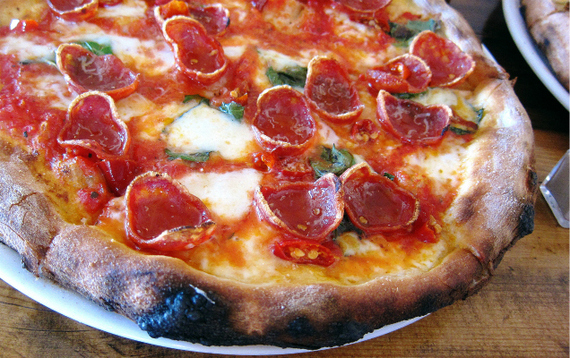
8. Durham, NC
A close community of chefs, purveyors, bakers, butchers, restaurateurs and others have steadily evolved the dining culture in Durham in recent years. The increasingly revitalized old tobacco town offers more than the whole-hog barbecue it's famous for, with a cache of restaurants that is evolving the present culinary scene while preserving the past. Downtown Durham has seen a rush of new businesses opening up in recent years. At the Five Points Intersection, look for spots like Mateo, Pizzeria Toro> and more.
7. Louisville, KY
This midsize city is a melting pot of the South and the Midwest, with a healthy splash of people who used to live in Brooklyn before they decided to relocate somewhere more affordable. That blend translates into a culinary scene that is constantly evolving and surprisingly diverse for a city more commonly associated with a colonel's fried chicken than with artisanal bread.
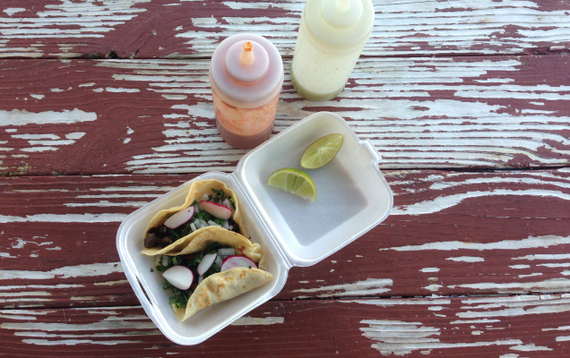
6. Nashville, TN
With the Americana Music Festival, the CMA Music Festival and more than 120 music venues that draw fans year-round, Music City lives up to its nickname more than ever. But in recent years the locus of its greatest creative growth has arguably been its dining scene. Leading the charge is James Beard award winner Sean Brock, who rose to national prominence for his work at McCrady's and his first restaurant, Husk, both in Charleston, South Carolina. The Nashville outpost occupies a part of town now known as SoBro, or South of Broadway, which is growing with steady stream of new residents, businesses, visitors -- and lots of good food.
5. Minneapolis/St. Paul, MN
Dining in the Twin Cities is all about a come-as-you-are experience with a focus on food. The hottest chefs here aren't limiting themselves to any particular cuisine, and they're as fluent in Asian herbs and spices (familiar thanks to three generations of Vietnamese and Hmong immigrants) as they are in Eastern European earthiness and Scandinavian simplicity.
To see the rest of America's Next Hot Food Cities, check out the full story on Zagat.
Like Zagat on Facebook
Follow Zagat on Twitter
Subscribe to Zagat on YouTube
-- This feed and its contents are the property of The Huffington Post, and use is subject to our terms. It may be used for personal consumption, but may not be distributed on a website.
How aspirin fights colorectal cancer
New prostate cancer treatment has promising results in mice
Warren Buffett, Drinker Of Five Cokes A Day, Sings Ukulele Ode To The Soda
Billionaire Warren Buffett took to his ukulele to sing an ode to Coke in honor of the 100th anniversary of the beverage's contoured bottle. The avid strummer played his own version of the popular "I'd Like to Buy the World a Coke" commercial from the 1970s, as part of a new ad celebrating the brand's iconic container.
Buffett, 84, made headlines earlier this year when he told Fortune's Patricia Sellers he was "one quarter Coca-Cola," and eats "like a six-year-old." He said he drinks at least five, 12-ounce servings of the beverage every day: regular Coke at the office and Cherry Coke at home.
Buffett may imbibe massive amounts of cola — and appear in their commercials — but he hasn't always been a fan of the company's decisions. Coca-Cola was reportedly pressured to change what Buffett called an "excessive" executive compensation plan after facing criticism from shareholders, The Wall Street Journal reported last May. His company, Berkshire Hathaway, holds $16 billion in Coca-Cola stock, about 9 percent of the company.
Business aside, the quirky anthem is a fitting serenade to the brand.
"I'd like to buy the world a coke and keep it company," Buffett sings. He adds, "Of course, I could buy the world a coke, but I'm not sure my shareholders would go for that."
OK, WARREN.
H/T MarketWatch
-- This feed and its contents are the property of The Huffington Post, and use is subject to our terms. It may be used for personal consumption, but may not be distributed on a website.
6 Signature Sips for Cinco de Mayo
BONUS: Find out how to make these delicious drinks at home, with exclusive recipes on trivago Checkin!
Cilantro Margarita
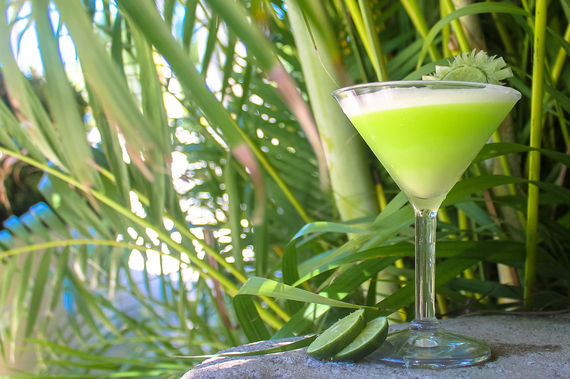
Where to sip: Casa Velas, Puerto Vallarta
Surrounded by one of the most beautiful golf courses in the country, Casa Velas is an all-inclusive boutique hotel for adults with unlimited possibilities for fun and relaxation. After a day of horseback riding, mountain climbing, or even swimming with dolphins, guests can refuel with a zesty Cilantro Margarita and some of the best Mexican and international gourmet cuisine in the area.

© Casa Velas
VIBE Margarita
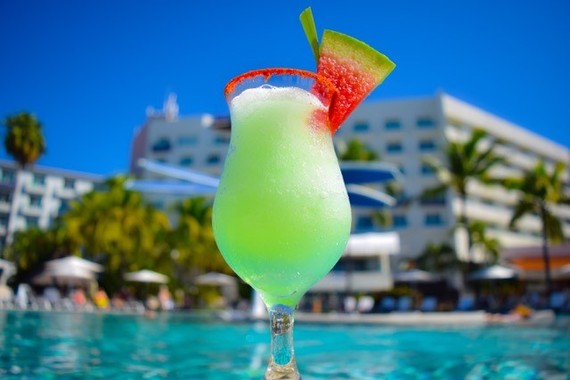
© Hard Rock Hotel Vallarta
Where to sip: Hard Rock Hotel Vallarta, Riviera Nayarit
With a gorgeous beachfront setting, modern design and breathtaking amenities, the Hard Rock Hotel Vallarta is a premier resort not to be missed. Its outdoor swimming pools, luxurious saunas, and outdoor amphitheater (with nightly theme parties) make it the perfect place to take advantage of Mexico's warm weather and scenic coastal views while sipping on an oh-so-sweet and spicy VIBE Margarita.

© Hard Rock Hotel Vallarta
Jalapeño Margarita
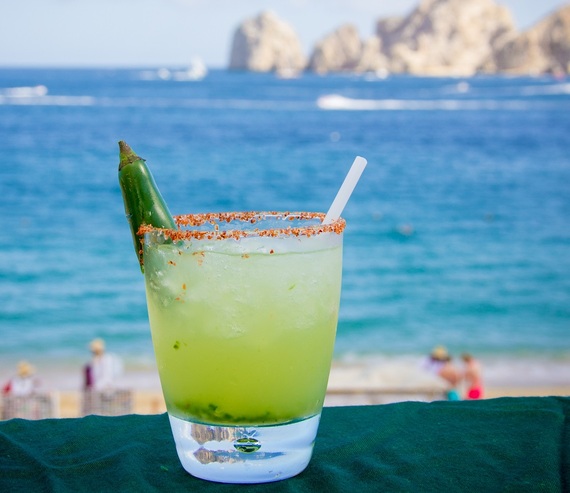
© Casa Dorada
Where to sip: Casa Dorada, Los Cabos
Situated along Medano Beach, the most swimmable beach in Cabo, Casa Dorada offers magnificent penthouses, lavish suites and even pet friendly accommodation. Soak up some sun on your private terrace while you indulge in a tangy Jalapeño Margarita, relax in the sanctuary of the Saltwater Spa or go for a delicious ice cream at Gelato Pazzo with the whole family!

© Casa Dorada
La Vida Verde Margarita
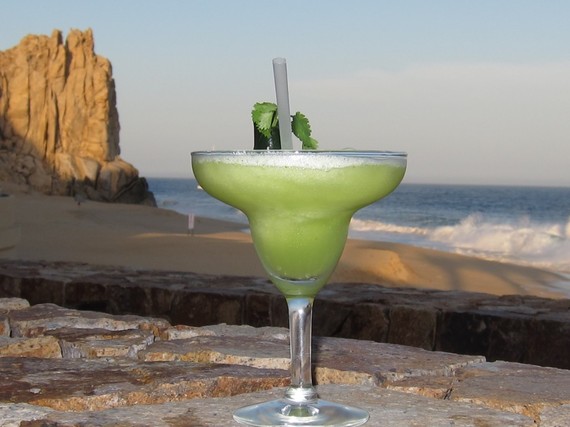
© Grand Solmar Land's End Resort & Spa
Where to sip: Grand Solmar Land's End Resort & Spa, Cabo San Lucas
Just a ten minute walk from Cabo's exciting nightlife, the Grand Solmar Land's End Resort & Spa is the perfect escape complete with pristine ocean views and private white sand beaches. The old world architecture and royal gardens will transport guests to a whole new world of serenity while they savor the freshest "Green Life" margarita, a tasty frozen treat whose name reflects the hotel's "Green" initiative.

© Grand Solmar Land's End Resort & Spa
Margarita Cancun

© Ritz-Carlton Cancun
Where to sip: Ritz-Carlton Cancun, Cancun
Named a AAA Five Diamond Resort for the 16th year in a row, the Ritz Carlton Cancun is a remarkable hotel with unmatched amenities and exceptional service. Guests can quench their thirst with a tasty Margarita Cancun in the oceanfront whirlpool and award-winning restaurants. Cooking lessons, tequila tasting, and sunrise yoga make a stay at the Ritz-Carlton Cancun a truly unique travel experience.

© Ritz-Carlton Cancun
Cucumber Margarita
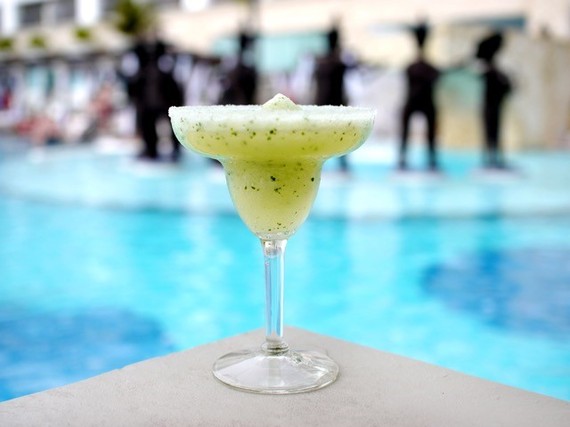
© Hyatt Zilara
Where to sip: Hyatt Zilara, Cancun
The all-inclusive and picturesque Hyatt Zilara is home to Cancun's only ocean view spa - the perfect place to relax with a refreshing Cucumber Margarita while taking in Mexico's famously stunning sunsets. This adult-only resort boasts numerous upscale amenities such as breathtaking outdoor pools, tennis courts, and several gourmet buffet restaurants, as well as live music and performances.

© Hyatt Zilara
Want more inspirational travel information? Visit trivago checkin.
-- This feed and its contents are the property of The Huffington Post, and use is subject to our terms. It may be used for personal consumption, but may not be distributed on a website.
Swine farming a risk factor for drug-resistant staph infections, study finds
Americans Deserve Open-Minded Discourse on Medical Options
For the most part, current medical treatment comes in the form of pills and procedures, which can save lives in acute emergencies but are inadequate for those interested in healing chronic illness or preventing it in the first place -- the latter of which makes up about 80 percent of a doctor's patient load. Conventional medicine is well-intended, of course, and numerous aspects are beneficial. Most notably, for an acute, life-threatening emergency, we just can't beat it. When someone has a heart attack, brain hemorrhage, or ruptured appendix, it is not the time for a doctor-patient consult on nutrition, meditation, and exercise. I am in no way suggesting that we through the baby out with the bathwater. Certainly, there are critical medical interventions that we want to keep in play.
As medical professionals, however, we need to think straight and accept that 15-minute exams and quick fix treatments usually do not work for complicated and chronic medical ailments. Often, they not only overlook the root of a problem, but they further exacerbate that problem by adding to the mix the side effects of medication and/or complications of surgery. In addition, quick fixes typically do not have a lasting effect on the psycho-emotional sense of wellness that fundamentally determines the quality of our lives. The American public is well aware of this reality, and it is hungry for alternatives.
Against the backdrop of a profit-driven health care system -- where self-interested pharmaceutical companies fund research studies on medical therapies; where doctors routinely prescribe drugs off-label, without credible scientific research verifying the efficacy of those uses; where the bottom line of insurance companies determines the course of treatment for patients; and where the lack of financial kickback leads to the under-funding, and therefore gross under-representation, of scientific studies on potentially curative holistic therapies -- Mehmet Oz, M.D. boldly has stepped into the health care gap, bringing to the public an open-minded exploration of and dialogue about cutting-edge and potentially more effective medical solutions.
Not only is it understandable that The Dr. Oz show is wildly popular, but it is not surprising that Dr. Oz has come under fire -- most recently, from doctors across the country asserting that Columbia University's affiliation with him is "unacceptable."
Indeed, throughout history, medical pioneers have come under vicious attack. Take the illustrative case of 19th century Ignaz Semmelweis, who discovered that hospital mortality could be drastically reduced if doctors washed their hands and disinfected their instruments between patients. With no scientific evidence backing up his claim, and with the idea of sterilization flying in the face of conventional medical practice at that time, Semmelweis not only lost his medical license but was committed to an insane asylum, where he was beaten to death at the age of 47. Decades later, his then-radical assertions were validated by scientific research, and today the medical community would be outraged if sterilization was not practiced by a doctor.
While science is comforting, it is neither unbiased nor foolproof. In the past few decades alone, scientific research led scores of Americans to believe that fat and cholesterol were the enemies of heart health, only to do a complete about-face. As noted in "The Government's Bad Diet Advice," a recent New York Times article, "For two generations, Americans ate fewer eggs and other animal products because policy makers told them that fat and cholesterol were bad for their health. Now both dogmas have been debunked in quick succession."
Keep in mind that the great scientists of the middle ages thought the world was flat and that anyone who thought otherwise was ridiculed. Which all goes to say, when we rigidly adhere to what science has proven or disproven up to a certain point in history, refusing to even consider other possibilities -- despite the consistent track record of science reversing itself over time -- we are not healthy skeptics. Instead, we are cynical dogmatists. When we attempt to impose our rigid dogma onto open-minded and compassionate physicians -- especially those who, like Dr. Oz, are willing to risk their reputations so as to uncover effective solutions for the scores of people who are suffering -- we are furthermore arrogant and heartless.
Scientific research follows in the footsteps of human experience. In recent times, this experience has demonstrated that the reductionist paradigm of conventional medicine -- which attempts to simplify one of the most complex systems imaginable, namely the human being -- is failing. The paradigm is breaking apart, as its limitations and drawbacks increasingly brought to light. While the public certainly does not want quackery, and while it prefers science when there is evidence, it needs and deserves knowledge about all the treatment options available.
Dr. Oz uses his extraordinary intelligence and mass appeal to illustrate the excitement of a world with numerous possibilities for healing. Though some of his claims may deservedly come under scrutiny, I think he is making a larger point that should neither be ignored nor ridiculed: He is challenging us all, medical professionals and laypeople alike, to think outside the box, in this case, the conventional medical toolbox. To use a home improvement analogy, Dr. Oz is saying that if a hammer is the only tool we own, that does not make it an appropriate tool for fixing a leaky faucet. Instead, it means we need to expand our awareness of the instruments available to us, and we need to add more tools to our collection.
Given the obviously urgent need to provide new and effective solutions for the public's common and chronic health challenges, I question the judgment of those who condemn Columbia University for affiliating with Dr. Oz. I similarly applaud the university for supporting the practice of a colleague who has the interest, courage, and wherewithal to cultivate an understanding of the spectrum of medical options available to the American public.
To be perfectly transparent, I am a former medical school classmate and current professional colleague of Dr. Oz. While some may say that puts into question or altogether disqualifies my opinion on this matter, I propose that the issue at hand has nothing to do with Dr. Oz or, by extension, his relationship to those who know him; instead, it has everything to do with the flow and control of information in the medical establishment. For decades, the politics and profit of conventional medicine have squelched the intelligence and creativity of medical professionals, with the implicit threat hanging over our heads that we will be discredited or even lose our licenses, if we do not tow the party line. Dr. Oz is simply the latest to break rank, take a stand, and feel the heat.
-- This feed and its contents are the property of The Huffington Post, and use is subject to our terms. It may be used for personal consumption, but may not be distributed on a website.
Prostate Cancer Treatment Market To Grow To $8.2 Billion
Two breast cancer studies show new hope for disease's victims
Voices Against Brain Cancer Continues The Fight For A Cure In Chicago With Its 3rd Annual "Join The Voices!" Run/Walk
There's A Surprising Reward At The End Of 'The Scariest Trail In The World'
This treacherous trail is a real, well-traveled route that runs up China's Mount Huashan, also known as Mount Hua. One of the country's five sacred mountains, it's located in central China's Shaanxi province.

Mount Hua actually consists of five peaks, and the most southern peak is home to a temple that holds tea ceremonies for any visitors daring enough to make the journey.
The stone staircase at the beginning of the hike is the easy part. That takes you to a gondola, which drops you at the southern peak's base.


The real fun comes in a cliffside path that consists of nothing more than footholds that have been hammered into the rocks and narrow, rickety planks hugging the side of the mountain. For a terrifying, firsthand view, take a look at this video:
After the plank-walk, you'll reach another stone stairway and finally, a Taoist temple, one of many on the mountain. There you'll find your well-earned cup of tea. It'd better be the best cup of tea in the world, because it's definitely the most difficult to get.
For more stomach-churning views, check out NPR's The Salt for a visual journey up the Western peak, where another elusive cup of tea awaits.
-- This feed and its contents are the property of The Huffington Post, and use is subject to our terms. It may be used for personal consumption, but may not be distributed on a website.
Celgene Sales Miss Estimates on Lung Cancer, Psoriasis Drugs
What AMC's "Mad Men" Tells Us About Healthcare
No Hogwarts invitation required: Invisibility cloaks move into the real-life classroom
Polygamous Marriage Is Linked To Higher Rates Of Literal Heartache For Husbands
Published: April 28, 2015 06:39pm ET on LiveScience.
Having more than one wife may cause some serious heartache.
Men who are polygamous face more than quadruple the risk of having blocked heart vessels, compared with men married to one woman, new research suggests.
"We found an association between an increasing number of wives and the severity and number of coronary blockages," study co-author Dr. Amin Daoulah, a cardiologist at the King Faisal Specialist Hospital and Research Centre in Jeddah, Saudi Arabia, said in a statement. This link could be due to the burden of maintaining several households, which can be costly both financially and emotionally, Daoulah said.
According to the Koran, men in polygamous marriages must treat each household fairly and equally. "It seems likely that the stress of doing that for several spouses and possibly several families of children is considerable," Daoulah said.
In the study, the more wives a man had, the greater his risk of heart disease, according to the findings presented today (April 29) at the Asian Pacific Society of Cardiology Congress 2015. [Life's Extremes: Monogamy vs. Polygamy]
However, the study does not prove a cause-and-effect relationship between polygamy and heart woes. It's possible that other, hidden factors, such as the level of intimacy in a marriage, eating habits or genetic factors, could play a role in polygamy and heart disease risk, Daoulah said.
Monogamy versus polygamy
A study published earlier this year in the journal Biology Letters suggests that men and women both fall on a continuum from monogamous to promiscuous, with slightly less than half of men, and slightly more than half of women, preferring to have only one serious partner at a time.
However, some scientists have argued that polygamy makes evolutionary sense for men, but not women. That's because polygamous men can have many more children than monogamous men during a given period, whereas women can have only one child every nine months, no matter how many partners they have during that span.
However, the children of monogamous couples don't have to share the father's time and resources with the children of other women. And studies show that wives of polygamous men tend to have fewer children on average than wives with monogamous husbands.
Moreover, polygamy may not be such a great deal for men, or society, either. Adding more people to the marital equation increases the potential for interpersonal conflict and requires more resources. A 2012 study in the journal Philosophical Transactions of the Royal Society B found that across time, societies that permit polygamy have higher rates of violence, poverty and gender inequality.
Heart problems with wives
To understand how the dynamics of polygamy may affect men's health, Daoulah and colleagues looked at men in the Middle East, where polygamy is more culturally accepted. In Islam, men are allowed to marry up to four different women, as long as they can support all of them and treat each wife and her children equally. (Each wife typically lives in a separate household in Islam.)
Daoulah's team followed 687 men who were referred for heart disease testing at five hospitals in Saudi Arabia and the United Arab Emirates. Among the men, 68 percent had one wife, 19 percent had two wives, 10 percent had three wives and 3 percent had four wives.
The men were 59 years old on average. More than half had high blood pressure and diabetes, and nearly half had a prior history of heart disease. Men who were polygamous tended to be older and to live in more rural areas, the researchers noted.
Compared with their monogamous counterparts, the polygamous men in the study had 4.6 times the risk of having narrowed coronary arteries, and 2.6 times the risk of having multiple narrowed arteries, according to the study.
Dr. Michel Komajda, a past president of the European Society of Cardiology who was not involved in the new study, said that stress may play a role in the link.
"We know that long-term stress in family life increases the risk of coronary heart disease," Komajda said in a statement. It would be interesting to see what effect polygamy had on wives' risk of coronary heart disease, he said.
People with psychological and social problems are less likely to take their heart medicine, which could also play a role in the problem, Komajda said.
Follow Tia Ghose on Twitter and Google+. Follow Live Science @livescience, Facebook & Google+. Originally published on Live Science.
- History of Marriage: 13 Surprising Facts
- I Don't: 5 Myths About Marriage
- 10 Wedding Traditions from Around the World
Copyright 2015 LiveScience, a Purch company. All rights reserved. This material may not be published, broadcast, rewritten or redistributed.
-- This feed and its contents are the property of The Huffington Post, and use is subject to our terms. It may be used for personal consumption, but may not be distributed on a website.
Experts Weigh In On Chipotle's GMO Foods Ban
Published: April 29, 2015 04:53pm ET on LiveScience.
Chipotle's decision to prepare only food that does not contain genetically modified ingredients is adding fuel to an ongoing debate about the health and safety of these foods.
The Mexican-style restaurant chain cited three reasons for removing GMO foods from its menu, saying on its website that scientists are still studying the long-term implications of GMOs, that the foods can damage the environment and that "Chipotle should be a place where people can eat food made with non-GMO ingredients."
But experts say the foods that contain GMOs that are currently grown in the United States are no riskier than conventionally grown foods.
The "growing international consensus" among scientific organizations is that foods made from currently approved genetically modified crops are safe to eat, said Gregory Jaffe, director of biotechnology at the Center for Science in the Public Interest, a consumer advocacy group based in Washington, D.C.
"This is not an ultrahazardous technology," Jaffe told Live Science. Although every new food product must be evaluated on a case-by-case basis, "all current applications are safe," he said.
GM foods are everywhere
Genetically modifying an organism involves inserting genes from one species into the DNA of another, in order to produce desirable traits, such as being resistant to pests.
There are currently eight genetically modified crops grown widely in the United States: corn, soybeans, cotton, alfalfa, sugar beets, zucchini, squash, and papaya. In fact, more than 90 percent of the country's total acreage of corn, soybeans, cotton and sugar beets comes from seeds that have at least one genetically engineered trait, Jaffe said.
And foods containing GMOs are tough to avoid because GM crops are found in processed foods such as high-fructose corn syrup, canola oil and soybean oil, he said.
Chipotle previously used genetically modified corn and soy as ingredients in its tortillas and cooking oil. Now, the company says it has replaced these with non-GM ingredients, such as rice bran oil and sunflower oil.
But people may not know that plant-based oils don't contain any DNA or protein, Jaffe noted. That means that GM soybean oil and non-GMsoybean oil are "biologically and chemically identical," he said.
At any rate, Chipotle's menu will not be completely GMO-free. According to its website, the company will still sell soft drinks that contain sweeteners made from genetically modified corn, and meat and dairy from animals that may be fed GM grains.
"It's obvious they're trying to market themselves to a certain demographic who they think this action will be important to," Jaffe said. "If they had really cared about eliminating GMOs in their stores, they should have gotten rid of the soda."
Are GM foods safe?
Foods derived from genetically engineered plants must meet the same safety standards as foods from traditionally bred plants, according to the U.S. Food and Drug Administration (FDA), which assesses the safety of both GM and non-GM foods before they go to market. (No food products from genetically engineered animals are currently on the market.)
"GM foods are safe if they have undergone the proper risk assessment to be put on the market," said Peter Ben Embarek, a food safety scientist with the World Health Organization in Geneva. "So far, all the GM products on the market [in the United States] have undergone such risk assessments," he said.
Still, consumers have argued that products containing GM ingredients should be labeled as such, and Ben Embarek said he favors giving people such information.
"Consumers are the ones who are buying the products … Therefore, they should have all the information in front of them," Ben Embarek told Live Science.
In 2013, Chipotle became the first restaurant chain to label items that contained GMOs.
But critics say that requiring all foods that contain GMOs to be labeled would only inflame public fears about these products.
And in any case, Jaffe said, discussions about Chipotle's decision not to use GM ingredients seem to overlook other aspects of the nutrition of the chain's meals, most of which have more than 1,000 calories and most of the daily allowance of sodium, as the New York Times previously reported.
"If they really wanted to improve people's health, they should worry a lot more about the salt and fat in their burritos than a little bit of soybean oil and a little cornmeal," Jaffe said.
Follow Tanya Lewis on Twitter. Follow us @livescience, Facebook & Google+. Original article on Live Science.
- 7 Biggest Diet Myths
- Science You Can Eat: 10 Things You Didn't Know About Food
- 5 Not-So-Miraculous Dr. Oz Claims
Copyright 2015 LiveScience, a Purch company. All rights reserved. This material may not be published, broadcast, rewritten or redistributed.
-- This feed and its contents are the property of The Huffington Post, and use is subject to our terms. It may be used for personal consumption, but may not be distributed on a website.
Impaired sleep linked to lower pain tolerance
8 Foods to Eat If You Want to Live Forever
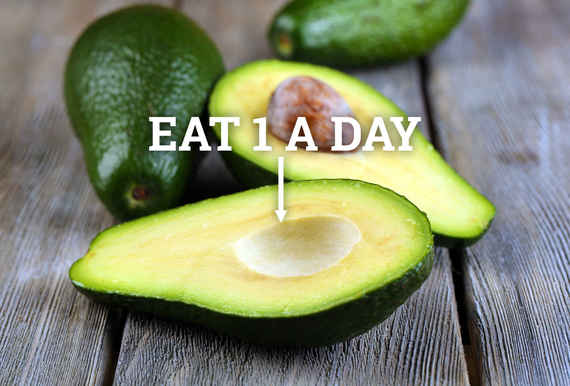
Credit: Shutterstock.com / Jennifer Bui/Thrillist
Unless you're Keith Richards, you can't actually live forever. But what you eat and drink affects whether you'll be letting your great-grandkids know you can't get no satisfaction when you're 113.
So we asked 11 registered dietitian nutritionists (RDNs) and spokespeople for the Academy of Nutrition and Dietetics the same question: "What one food should I eat every day if I want to live a long, healthy life? Why?" Grab a bag of nuts and read on to find out what you should be incorporating into your diet so that you can live almost as long as Keef.
More: The Pizza Cleanse: Testing the Benefits of Eating Only Pizza for 5 Days Straight
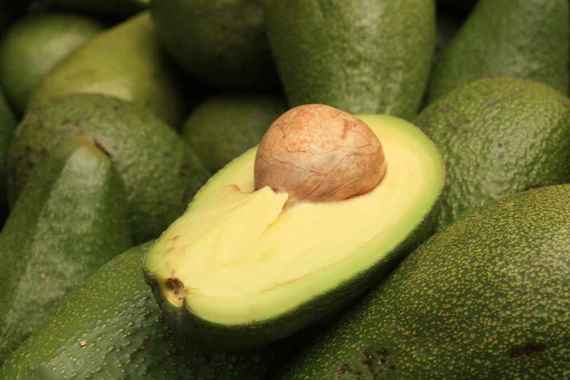
Credit: Flickr/Jaanus Silla
Avocado
"I may be a little biased because I'm Mexican, but this fruit offers the complete nutritional package. Filled with monounsaturated fats, which are shown to help inflammation and improve cholesterol, avocados are also high in fiber, potassium, folate, and vitamin E.
"People may fear them due to their high caloric content, but it's not always about calories -- it's about nutrients too. Avocados will help you feel fuller due to the high concentrations of fat and fiber. Best part? Avocados go with anything, from breakfast sandwiches to salads to dips!" - Marina Chaparro, MPH, RDN, CDE, LD

Credit: Flickr/Harry
Walnuts
"While I would love to hold on to a youthful physical appearance with great skin and shiny hair, what I really care about is the health of my brain. Eating one serving of nuts a day (in particular, walnuts!) has been shown to play a role in Alzheimer's prevention, boost memory, and reduce depression. Good things come in small packages." - Jennifer McDaniel, MS, RDN, CSSD, LD

Credit: Flickr/Rebecca Siegel
Beans
"Beans are an amazing plant-based protein. They have no fat, sodium, or cholesterol, and are fat-free. They are rich in fiber, phytochemicals, protein, iron, magnesium, certain B vitamins, and potassium. These nutrients provide great prevention benefits for long-term health. They help protect against obesity, colon cancer, diabetes, and heart disease.
"The fiber fills you up so you can use it to help with weight management as well as diabetic blood sugar control, and it's also been shown to lower LDL levels. There are so many beans to choose from and they are versatile for cooking -- add them to salads, soups, side dishes, or casseroles. They are easy, economical, and convenient -- just open a can! They fill you up and keep blood sugars stable. They are a good calorie investment at 115 calories per half-cup, and they are a nutrient-rich choice!" - Kim Larson, RDN, CD, CSSD
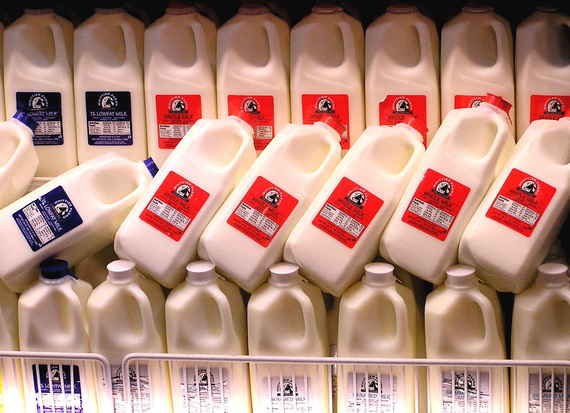
Credit: Flickr/liz west
Milk
"Milk supplies three of the four nutrients that Americans are most likely to miss out on -- potassium, calcium, and vitamin D (but not fiber). Plus, Americans only get about half of the recommended three servings a day of dairy. As an RDN, I find that if people are not consuming milk, they don't get enough calcium or the recommended three servings a day of dairy foods. Even though they theoretically could get enough from yogurt or cheese, in my experience, they don't.
"How can you enjoy more milk? Instead of hitting F7 on the vending machine for a candy bar to get over that mid-afternoon slump, pop the top of a carton of chocolate milk. Or heat milk in the microwave and add your favorite flavor of coffee syrup. At the coffee shop, swap your coffee for a latte. A 12oz latte has 8oz of milk -- and skim milk froths up better than full-fat varieties." - Isabel Maples, RDN
For 4 more nutritionist-backed superfoods you should definitely be eating, head over to Thrillist.com!
More from Thrillist:
The 21 Best Vegetarian/Vegan Restaurants in America
How I Got 14 Companies Like Chipotle and Trader Joe's to Send Me Free Stuff
Like Thrillist on Facebook: www.facebook.com/Thrillist
-- This feed and its contents are the property of The Huffington Post, and use is subject to our terms. It may be used for personal consumption, but may not be distributed on a website.
Playing 'Tetris' Can Change Your Brain. Here's How
A new video from BrainCraft, an educational show from PBS Digital studios, explains what "Tetris" does to your brain -- and a lot of it is good news.
According to the video, studies have shown that playing enough "Tetris" (think 1.5 hours a week for three months) can ...
• Make parts of your cerebral cortex thicker.
• Make other areas of your brain more efficient.
• Reduce flashbacks for people with post-traumatic stress disorder.

The smartest kid in the world. (Source)
Of course, this all comes with some caveats. The video explains that doing any task for three months could potentially change your brain structure.
What makes "Tetris" is addictive, the video explains, is that it "appeals to our natural desire to organize things, complete tasks and achieve goals." The game gives you a constant stream of "incomplete tasks" -- there's always a new block to consider and place in the game, which keeps your brain hooked.
Of course, no two people are the same, and "Tetris" impacts everyone differently. For more detail, watch the video above or on YouTube.
"Tetris" has long fascinated scientists. A 2009 study from the Mind Research Network examined the impact of the game on the human brain, and in 2000, researchers at Harvard Medical School found that it can change how people dream. Others have written about how the game can be habit-forming and change how we think about the world around us -- a notion that's now referred to as the "Tetris effect."
-- This feed and its contents are the property of The Huffington Post, and use is subject to our terms. It may be used for personal consumption, but may not be distributed on a website.
Brave breast cancer runner from Barnsley celebrates engagement as partner goes down on one knee at finish of London Marathon
Prostate Cancer Combination Treatment Could Beat Disease at Its Own Game: Early Study
An Investigational Immunotherapy for Lung Cancer
'Dead zones' found in Atlantic open waters: Moving west, could lead to mass fish kills
What Happened To The 3-Year-Old 'Oprah Show' Guest Who Was Obsessed With Her Looks?
"The worst fights are the lipstick," Margie said back then. "She comes and tells me, 'I don't look beautiful! I want lipstick!' And she wants me to buy her makeup."
When Margie refused these requests, Jordyn would scream, cry and tell her mother, "I hate you" and "I don't love you."
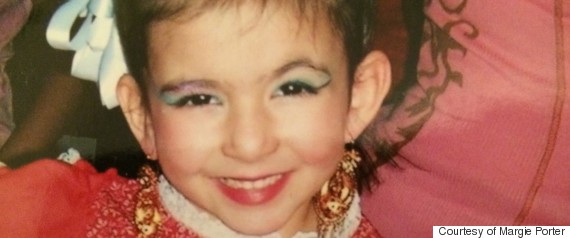
Margie felt lost, and couldn't help but feel the pain of her own childhood resurfacing in her daughter's insecurities. "I do not recall ever being told, 'You're beautiful,' so I'm constantly telling her how beautiful she is," Margie admitted. "I just don't want her to feel the way I did... But I've missed the mark in making her feel the inner beauty."
Her biggest fear as a mother, she added, was what Jordyn's obsession with looks would mean for the girl's future. "I'm scared of where my daughter will end up in 10 years," she told Oprah.
It's now been nine years since that show, and "Oprah: Where Are They Now?" recently caught up with both Margie and Jordyn, now 12, at their home in New Mexico.
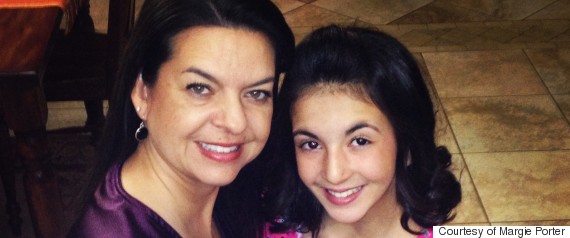
"After the show, one of the aha! moments was that I needed to reflect upon the way I was projecting out to my daughter," Margie says in the above video. "And [start] looking within myself to see what I was doing and what I could change so that she can get a more positive outlook."
Today, Jordyn says that she has learned to better appreciate her inner beauty. "My mom always told me, 'When you be kind to others and whenever you're sweet, you're beautiful on the inside," she says. "So... whenever I'm being nice and sweet, I feel beautiful."
Now a middle school student in the sixth grade, Jordyn juggles a full schedule of extracurricular activities and academics. "I got the lead role in my school play, I am a cheerleader for my school and I have gotten straight-A's," she says.
Yet, even with her accomplishments and sense of inner beauty, she still admits to experiencing some of her old insecurities.
"I still do struggle with the way I look, and it's really hard," Jordyn says. "Journaling really helps me because I can just write down my feelings and let it go."
Margie, of course, is always ready with words of support and encouragement.
"I help Jordyn on the tough days by always repeating how beautiful she is, all her wonderful qualities," Margie says. "I just try to remind her that I love her with all my heart... She is beautiful both on the inside and on the outside."
"Oprah: Where Are They Now?" airs Saturdays at 9 p.m. ET on OWN.
 Like Us On Facebook |
Like Us On Facebook |  Follow Us On Twitter
Follow Us On Twitter-- This feed and its contents are the property of The Huffington Post, and use is subject to our terms. It may be used for personal consumption, but may not be distributed on a website.
Domino's Pizza Doesn't Care About Feeding Vegans
PETA's idea of incorporating cruelty-free food in the kitchen was more than handily nixed: Fewer than 0.28 percent of votes from Domino's shareholders supported the vegan proposal, the Detroit Free Press reported.
Tim McIntyre, Domino's vice president of communications, said that the company has tested vegan cheese before, but it didn't perform. He also said there are no signs that Domino's customers want vegan options.
"The Board of Directors did recommend that shareholders vote against it, as there has been no consumer interest in vegan toppings from Domino’s," McIntyre wrote to The Huffington Post in an email, adding, "We believe we know more about testing and rolling out products for our brand than PETA does, and we know how to run our business better than PETA does."

PETA owns 39 shares of Domino's stock worth about $3,000, which McIntyre referred to as "basically the minimum amount of shares you need to own to put a resolution on a public company’s proxy."
In the past few years, the animal welfare advocates have made an impact with other companies. The organization moved Chipotle to incorporate more humane slaughtering practices, and pushed IKEA and Subway to include vegan offerings on their menus.
"Other companies are responding and we think Domino's needs to look to the future if it wants to rebrand itself," said David Byer, a senior corporate liaison for PETA. "Domino's has an opportunity to reduce the suffering of animals in its supply change while offering a healthier option."
Pizza chain Blaze Pizza offers vegan cheeses on its menu, but has fewer than 100 locations in the U.S. There are more than 5,000 Domino's locations across the country, and the company does offer a handful of vegetarian options.
"I would like to note that neither our dough nor our pizza sauce contain animal products," McIntyre said. "There are plenty of vegetarian options among the 34 million possible combinations of pizza at Domino’s."
That's true. The ingredients in Domino's pizza sauce are all vegan: Tomato puree (water, tomato paste), sugar, salt, spices, garlic, soybean oil, and citric acid. On its website, PETA provides a guide for ordering "veganized" pizza at most chain pizza restaurants, including Domino's. PETA writes that most chain restaurants' dough and sauce is vegan, so ordering a cheese-less pie with veggie toppings can suit an herbivore.
However, the hearty marinara sauce at Domino's contains chicken juices and chicken fat, which is clearly neither vegan or vegetarian. (This sauce is primarily used for Domino's pasta offerings.) Veg heads might want to remember that the next time they order from the chain.
-- This feed and its contents are the property of The Huffington Post, and use is subject to our terms. It may be used for personal consumption, but may not be distributed on a website.
Announces Publication of Oncotype DX® Prostate Cancer Test Decision Impact Study in Urology Practice, Supporting Wider Adoption and Reimbursement
Living to 100: Lifestyle advice for would-be centenarians
Want A Healthy Brain? Better Avoid These 7 Habits
A lot of it has to do with genetics, but certain lifestyle factors also play an important role in how our brain ages. So while you can't control your genes, you can take advantage of the latest science and avoid these seven big brain mistakes:
Mistake No. 1: Eating a standard American diet
Foods high in sugar, unhealthy fats and processed foods -- i.e., the typical American diet -- can wreak havoc on your brain over time. Studies have shown that excess sugar consumption can impair learning and memory, and increase your vulnerability to neurodegenerative diseases like Alzheimer's. Some scientists have even referred to Alzheimer's as "Type 3 Diabetes," suggesting that diet may have some role in an individual's risk for developing the disease.
A Mediterranean-based diet, on the other hand, can help protect the brain from signs of aging and ward off cognitive decline. A recent study showed that following this type of diet -- which is a good source of brain-healthy nutrients and includes a lot of fish, healthy fats, whole grains and vegetables -- could slash Alzheimer's risk by up to 50 percent.
Mistake No. 2: Living next to a highway
Living in a smoggy city might be bad news for your brain. According to research published this month in the journal Stroke, exposure to air pollution is linked with premature aging of the brain.
The researchers found that people who lived closer to a major highway had greater markers of pollution in their lungs and blood, which increased their risk for a form of brain damage known as "silent strokes," or symptomless strokes. Increased pollution volume was also linked to decreased brain volume -- a major sign of aging.
Mistake No. 3: Drinking a few evening cocktails
Don Draper's daily cigarettes and two-martini lunches might seem glamorous on "Mad Men," but research suggests that they're a fast track to neurodegeneration.
It should come as no surprise that excessive drinking and cigarette smoking at any stage of life can have a negative effect on the brain, damaging brain tissue and leading to cognitive impairment. Alcoholism can cause or accelerate aging of the brain.
But just a couple of glasses of wine a night could pose a risk to brain health, even though there are some cardiovascular benefits. A 2012 Rutgers University study found that moderate to binge drinking -- drinking relatively lightly during the week and then more on the weekends -- can decrease adult brain cell production by 40 percent.
"In the short term there may not be any noticeable motor skills or overall functioning problems, but in the long term this type of behavior could have an adverse effect on learning and memory," one of the study's authors, Rutgers neuroscience graduate student Megan Anderson, said in a statement.
Mistake No. 4: Giving in to stress
Living a stressful lifestyle may be the worst thing you can do for your health as you age. Chronic stress is known to shorten the length of telomeres, the sequences at the end of DNA strands that help determine how fast (or slow) the cells in our body age. By shortening telomeres, stress can accelerate the onset of age-related health problems.
What about the brain? Well, some research has suggested that high levels of stress hormones can increase an individual's risk for age-related brain damage.
"Over the course of a lifetime, the effects of chronic stress can accumulate and become a risk factor for cognitive decline and Alzheimer's disease," Howard Fillit, a clinical professor of geriatric medicine at The Mount Sinai School of Medicine, wrote in Psychology Today. "Several studies have shown that stress, and particularly one's individual way of reacting to stress (the propensity to become 'dis-stressed' often found in neurotic people for example), increases the risk for Alzheimer's disease."
If you're feeling stressed out, try picking up a meditation practice. Research has shown that meditation is effective in lowering levels of the stress hormone cortisol and protecting the brain from aging.
Mistake No. 5: Getting by on less sleep than you need
There are a number of scary health effects associated with sleep deprivation, from a higher risk of stroke and diabetes to impaired cognitive functioning. Over the years, losing shut-eye can also accelerate brain aging. In a study conducted last year, researchers from Singapore found that the less that older adults slept, the faster their brains aged.
The study's lead author explained in a statement that among older adults, "sleeping less will increase the rate their brain ages and speed up the decline in their cognitive functions."
Mistake No. 6: Sitting all day
It's a well-established fact that sitting for long periods is terrible for your health. A growing body of research has linked a sedentary lifestyle with health risks including heart disease, diabetes, cancer and early death, even among people who get the recommended daily amount of exercise.
And it turns out that sitting is also pretty bad for your brain. Research has linked physical inactivity with cognitive decline. Moreover, weight gain in older adults -- which may result from too much sitting -- has been linked with shrinkage in brain areas associated with memory.
So when in doubt, move around. Physical activity has been linked with a number of brain health benefits, including improved learning and memory.
Mistake No. 7: Zoning out
Use it or lose it! If you want to keep your brain sharp, keep it engaged. It doesn't have to be a challenging intellectual task or a brain-training game, either -- simply engaging in everyday activities like reading, cooking or having a conversation (as opposed to vegging out in front of the TV or computer) can make a difference.
But mental exercises like crossword puzzles and sudoku can help, too. A 2013 study published in the Canadian Medical Association Journal found that brain exercises are more effective than drugs in preventing cognitive line.
The bottom line? Doing new and novel things promotes neurogenesis, the creation of new neurons in the brain. So get outside, learn, discover and try something new to keep your brain sharp through the decades.
-- This feed and its contents are the property of The Huffington Post, and use is subject to our terms. It may be used for personal consumption, but may not be distributed on a website.
What AMC's Mad Men Tells Us About Healthcare
One town's big business: asbestos lawsuits
13 Things Anyone Who Loves A Highly Sensitive Person Should Know
Many of my friends lovingly tease me about my emotional reactivity, but it's certainly not like I can control it. Some people are just more sensitive than others, and that's not always a bad thing. I'm also not alone: Approximately one in five people -- women and men -- can be classified HSP, or as a highly sensitive person, according to HSP researcher and psychologist Elaine Aron, Ph.D. That makes it highly likely you know and love someone with the personality trait.
Below are a few things to keep in mind about your highly sensitive loved ones.

1. We're going to cry.
When we're happy, when we're sad and when we're angry. That's because highly sensitive people just naturally feel more deeply and react accordingly.
2. Not all of us are introverts.
Introversion does not equal sensitivity. In fact, according to Aron's research, approximately 30 percent of highly sensitive people are extroverts.
3. Decisions make us nervous.
Highly sensitive individuals are notoriously bad at making choices -- even if it's just picking out where to go to dinner. This is mostly because we agonize over the possibility of making the wrong one. (What if the food is bad?!)
4. We notice that subtle change in your tone.
If you normally end each text message with an exclamation point and lately you've been using a period, you better believe we'll pick up on it. Highly sensitive people are generally more intuitive when it comes to the tiny nuances of our environment and we're more affected by shifts in other people's moods.
5. We're always willing to hear you vent.
Don't be afraid to reach out to use us when you need a shoulder to lean on. Our overly-empathetic nature allows us to be excellent listeners when you need it, because when you feel pain so do we -- and we want to do whatever we can to make you feel comfortable. Highly sensitive people make excellent teachers, therapists and managers for this reason.
6. Repetitive and loud noises are the worst.
Loud chewing, a barreling train, boisterous co-workers: You name it, we're sensitive to it. That's because chaotic or overstimulating environments have more of an influence on HSPs, according to Aron.
7. Our workplace habits are a bit atypical.
Working from home or in a quiet space is a dream for highly sensitive people -- especially because it allows us to focus if we become too overwhelmed. However, don't let our solo work ethic fool you. "Sensitive people can use their observations to their advantage ... They're going to rise to the top," Aron previously told HuffPost. "They know how to bring ideas up without being ridiculed or scorned." HSPs also make excellent team players due to our analytical nature and thoughtfulness for others' ideas (just don't force us to make the final decision on a project).
8. Don't ask us to see that new slasher movie.
That same high empathy we experience for others combined with overstimulation makes gory, violent films truly terrible for highly sensitive people.
9. Criticism is incredibly distressing.
As a result, we tend to avoid anything that may cause those feelings of shame. This may mean we engage in people-pleasing or self-deprecating behavior more than most of our peers. In other words, we're far from perfect.
10. We're constantly being told we take things too personally.
A joke at our expense sometimes just isn't a joke to us. We know it's a little silly to be upset, but what else are we supposed to do with all of our feelings?
11. We have a low pain tolerance.
Pass the ice, please. It doesn't matter if it's a broken arm or just a stubbed toe, any injury really hurts. This is because highly sensitive people are more affected by pain than others, according to Aron's research.
12. We crave deep relationships.
According to Aron, highly sensitive people tend to get more bored in marriages than non-HSP couples, mostly due to the lack of meaningful interaction that naturally occurs as time goes on. However, this doesn't necessarily mean we're dissatisfied with the relationship -- we just need to find a way to have more stimulating conversations.
13. We can't just stop being highly sensitive.
A 2014 study published in the journal Brain and Behavior found that highly sensitive people experienced more activity in regions of the brain associated with empathy and awareness when exposed to pictures of emotional individuals than the average person. In other words, we're neurologically wired to behave the way that we do.
With that in mind, know that the best way to love us is to support us. Try not to shame us for our sensitivity. Tell us it's okay to feel the way we do. And in return, we'll try not to tear up over your kind words (no promises, though).
-- This feed and its contents are the property of The Huffington Post, and use is subject to our terms. It may be used for personal consumption, but may not be distributed on a website.